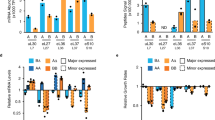Abstract
A duplicate copy of the RPL37A gene (encoding ribosomal protein L37) was cloned and sequenced. The coding region of RPL37B is very similar to that of RPL37A, with only one conservative amino-acid difference. However, the intron and flanking sequences of the two genes are extremely dissimilar. Disruption experiments indicate that the two loci are not functionally equivalent: disruption of RPL37B was insignificant, but disruption of RPL37A severely impaired the growth rate of the cell. When both RPL37 loci are disrupted, the cell is unable to grow at all, indicating that rpL37 is an essential protein. The functional disparity between the two RPL37 loci could be explained by differential gene expression. The results of two experiments support this idea: gene fusion of RPL37A to a reporter gene resulted in six-fold higher mRNA levels than was generated by the same reporter gene fused to RPL37B, and a modest increase in gene dosage of RPL37B overcame the lack of a functional RPL37A gene.
Similar content being viewed by others
References
Abovich N, Gritz L, Tung L, Rosbash M (1985) Effect of RP51 gene dosage alterations on ribosome synthesis in Saccharomyces cerevisiae. Mol Cell Biol 5:3429–3435
Carey M, Lin Y-S, Green MR, Ptashne M (1990) A mechanism for synergistic activation of a mammalian gene by GAL4 derivatives. Nature 345:361–364
Chasman DI, Lue NF, Buchman AR, LaPointe JW, Lorch Y, Kornberg RD (1990) A yeast protein that influences the chromatin structure of UASG and functions as a powerful auxiliary gene activator. Genes Dev 4:503–514
Donovan DM, Remington MP, Stewart DA, Crouse JC, Miles DJ, Pearson NJ (1990) Functional analysis of a duplicated linked pair of ribosomal protein genes in Saccharomyces cerevisiae. Mol Cell Biol 10:6097–6100
Eng FJ, Warner JR (1991) Structural basis for the regulation of splicing of a yeast messenger RNA Cell 65:797–804
Grunstein M, Hogness D (1975) Colony hybridization: a method for the isolation of cloned DNAs that contain a specific gene. Proc Natl Acad Sci USA 72:3961–3965
Hughes JMX, Konings DAM, Cesareni G (1987) The yeast homologue of U3 snRNA. EMBO J 6:2145–2155
Ito H, Fukuda Y, Murata K, Kimura A (1983) Transformation of intact yeast cells treated with alkali cation. J Bacteriol 153:163–168
Kambouris NG, Burke DJ, Creutz CE (1993) Cloning and genetic analysis of the gene encoding a new protein kinase in Saccharomyces cerevisiae. Yeast 9:141–150
Lin Y-S, Carey MF, Ptashne M, Green MR (1988) GAL4 derivatives function alone and synergistically with mammalian activators in vitro. Cell 54:659–664
Lucioli A, Presutti C, Ciafre S, Caffarelli E, Fragapane P, Bozzoni I (1988) Gene dosage alteration of L2 ribosomal protein genes in Saccharomyces cerevisiae: effects on ribosome synthesis. Mol Cell Biol 8:4792–4798
Morrow BE, Ju Q, Warner JR (1990) Purification and characterization of the yeart rDNA-binding protein REB1. J Biol Chem 265: 20778–20783
Nasmyth KA, Tatchell K (1980) Structure of transposable yeast mating-type loci. Cell 19:753–764
Ollviero S, Struhl K (1991) Synergistic transcriptional enhancement does not depend on the number of acidic activation domains bound to the promoter. Proc Natl Acad Sci USA 88:224–228
Otaka E, Higo K, Osawa S (1982) Isolation of seventeen proteins and amino-terminal amino-acid sequences of eight proteins from cytoplasmic ribosomes of yeast. Biochemistry 21:4545–4550
Otaka E, Higo K, Itoh T (1984) Yeast ribosomal proteins. VIII. Isolation of two proteins and sequence characterization of twenty-four proteins from cytoplasmic ribosomes. Mol Gen Genet 195: 544–546
Riles L, Dutchik JE, Baktha A, McCauley BK, Thayer EC, Leckie MP, Braden VV, Depke JE, Olson MV (1993) Physical maps of the six smallest chromosomes of Saccharomyces cerevisiae at a resolution of 2.6 kilobase pairs. Genetics 134:81–150
Rose MD, Winston F, Hieter P (1990) Methods in yeast genetics. Cold Spring Harbor Laboratory, Cold Spring Harbor, New York
Rotenberg MO, Moritz M, Woolford JL, Jr. (1988) Depletion of Saccharomyces cerevisiae ribosomal protein L16 causes a decrease in 60s ribosomal subunits and formation of polyribosomes. Genes Dev 2:160–172
Santangelo GM, Tornow J (1990) Efficient transcription of the glycolytic gene ADH1 and three translational component genes require the GCR1 product, which can act through TUF/GRF/RAP-binding sites. Mol Cell Biol 10:859–862
Santangelo GM, Tornow J, McLaughlin CS, Moldave K (1988) Properties of promoters cloned randomly from the Saccharomyces cerevisiae genome. Mol Cell Biol 8:4217–4224
Santangelo GM, Tornow J, McLaughlin CS, Moldave K (1991) Screening a yeast promoter library leads to the isolation of the RP29/L32 and SNR17B/RPL37A divergent promoters and the discovery of a gene encoding L37. Gene 105:137–138
Sorger PK, Nelson HCM (1989) Trimerization of a yeast transpriptional activator via a coiled-coil motif. Cell 59:807–813
Southern EM (1975) Detection of specific sequences among DNA fragments separated by gel electrophoresis. J Mol Biol 98: 503–517
Tornow J, Santangelo GM (1990) Efficient expression of the Saccharomyces cerevisiae glycolytic gene ADH1 is dependent upon a cis-acting regulatory element (USA RPG) found initially in genes encoding ribosomal proteins. Gene 90:79–85
Tornow J, Zeng X, Gao W, Santangelo GM (1993) GCR1, a transcriptional activator in Saccharomyces cerevisiae, complexes with RAP1 and can function without its DNA-binding domain. EMBO J 12:2431–2437
Woolford JL Jr, Warner JR (1991) The ribosome and its synthesis In: Broach JR, Jones EW, Pringle JR (eds) The molecular and cellular biology of the yeast Saccharomyces: genome dynamics, protein synthesis, and energetics. Cold Spring Harbor Laboratory, Cold Spring Harbor, New York
Author information
Authors and Affiliations
Additional information
Communicated by B. B. Sears
Rights and permissions
About this article
Cite this article
Tornow, J., Santangelo, G.M. Saccharomyces cerevisiae ribosomal protein L37 is encoded by duplicate genes that are differentially expressed. Curr Genet 25, 480–487 (1994). https://doi.org/10.1007/BF00351666
Received:
Accepted:
Issue Date:
DOI: https://doi.org/10.1007/BF00351666




